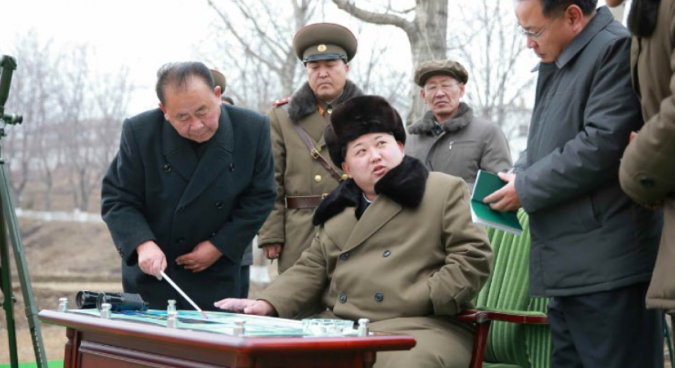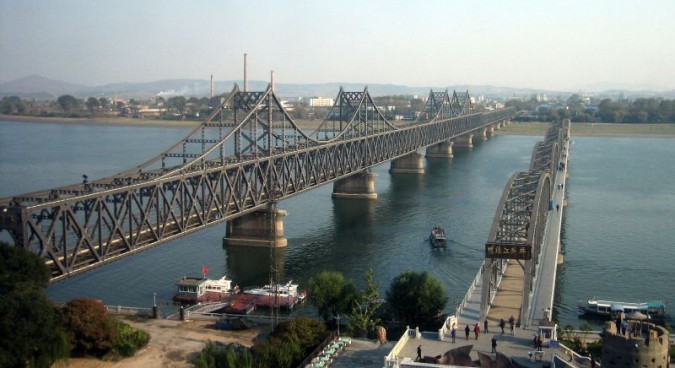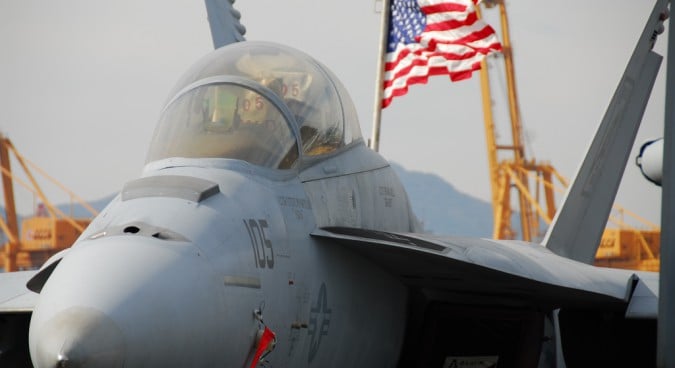This article was contributed to NK News by the DPRK’s Institute for Disarmament and Peace, Ministry of Foreign Affairs on Tuesday.
The North Korean state media custom of lower-casing the first letters in “north” and “south” Korea – reflecting the view that they are legitimately one nation – has been maintained.
Several of the purported facts and opinions within are not those of NK News but are representative of North Korea.
A lot of water has flowed under the bridge since the end of Cold War. The world has made tremendous advances and the times have undergone dramatic changes. But one place remains unchanged and that is the Korean Peninsula.
Despite the end of the Cold War, the Korean Peninsula finds itself caught in the state of armistice and both belligerents have leveled their guns at each other for more than half a century.
The Korean Peninsula has already been ranked as the biggest and most highly explosive powder magazine in the world and a fuse for a new world war.
THE MAIN CAUSE OF TENSION ON THE KOREAN PENINSULA
The Democratic People’s Republic of Korea is a peace-loving nation.
The DPRK, unlike the U.S., has neither invaded other nations with armed forces nor conducted any large-scale bilateral or multilateral joint military drills abroad against a third country
The DPRK, unlike the U.S., has neither invaded other nations with armed forces nor conducted any large-scale bilateral or multilateral joint military drills abroad against a third country (Editors note: Most historians agree the Korean War begun when North Korean tanks crossed the 38th parallel on June 25, 1950).
However, in the last 70 years since its occupation of south Korea, the U.S. has staged annually all kinds of aggressive war drills in the south and its vicinity against the DPRK, several thousand miles away from the U.S., thus driving the situation on the Korean Peninsula and the region to the brink of war.
HINDERING INTER-KOREAN RELATIONS AND REUNIFICATION
It is well-known that the U.S. is the very culprit which occupied south Korea under the guise of “liberator” following Japan’s defeat in World War II, thus dividing the homogeneous nation of Korea and its soil into north and south.
From the early days of its illegal and unlawful occupation of south Korea, turning south Korea into its full colony, the U.S. has been desperate and impudent in portraying itself as a “defender” of world peace and security while slandering the DPRK as a “criminal” destroying peace and security in order to mislead the world option.
In the last 70 years, the U.S. has been clinging to ceaseless military build-up, new war provocations and drills against the DPRK with the strategy of maintaining tension on the Korean Peninsula to isolate and stifle the DPRK and interrupt the improvement of inter-Korean relations.
Let us look back upon the facts of how the U.S. has persistently undermined peace and security and aggravated tension on the Korean Peninsula through joint military exercises.
In 1945, when Korea was liberated from Japanese colonial rule the U.S. occupied south Korea and turned south Korea into its complete colony and instigated the Syngman Rhee puppet clique to stage war drills and military provocations against the north along the 38th parallel and in the end sparked the Korean War in 1950 with an ambition of halting the nationwide struggle of the Korean people, aspirant after a unified state, and to put the north under its domination.
Pursuant to the provisions of the Armistice Agreement the political conference for peaceful settlement of the Korean Peninsula took place in Geneva. However, the U.S. broke off the conference by conducting Focus Lens, a joint military exercises with south Korea, in 1954 and later in the 1960s, continued to aggravate the situation with the Focus Retina and Eagle joint military exercises.
In the early 1970s, the July 4th North-South Joint Statement for reunifying Korea based on the three principles of independence, peace and great national unity was made public thanks to the active and generous initiatives of the DPRK. At the same time, tendency toward the independent peaceful reunification was growing rapidly on the peninsula. The U.S. got nervous about these developments on the peninsula and put pressure on Park Chung-hee, the then-dictator in south Korea, to overturn the Joint Statement and started the Team Spirit and Ulji Focus Lens joint military exercises in 1976, thus driving the inter-Korean relations to a new confrontation.
When the Korean people’s expectations and aspirations for national reunification grew fervent through the announcement of an Agreement on Reconciliation, Non-Aggression, and Exchanges and Cooperation between the North and the South in 1992, the U.S. restarted the Team Spirit joint military exercises again in 1993 to turn the situation to another catastrophe.
Entering the 2000s, the June 15 era opened between the north and the south and aspirations after reunification and anti-U.S. sentiment grew higher, and even a call for a transfer of wartime operational control (OPCON) of the south Korean army took place in south Korea. To check these developments, the U.S. again resorted to joint military exercises.
Last year, the U.S. overlooked and encouraged tacitly the south Korean army’s provocative “landmine explosion” and “shell fired by the north” incidents, which occurred during the Ulji Freedom Guardian military exercises, thus driving the situation on the peninsula to the brink of war again.
THE AGGRESSIVE NATURE OF THE JOINT MILITARY EXERCISES
The joint military exercises annually staged by the U.S. and south Korea on the Korean peninsula are quite different from military exercises of other countries in terms of both frequency and purpose.
The U.S.-led RIMPAC naval joint military exercises, the world biggest in scale, is held every two years. In RIMPAC 2014, 23 countries, 47 vessels, 6 submarines and 200 aircrafts were involved, but the total number of troops amounted to only 25,000.
In the case of Cobra Gold, the biggest annual joint military exercises in Asia, less than 10,000 troops from 28 countries are participating in the drill and the duration is around 10 days.
The NATO-led Swift Response 15, the biggest in Europe since the end of the Cold War, also involves only 5,000 troops from around 10 countries.
However, the U.S. and south Korea hold annually more than 40 joint military exercises such as Key Resolve, Foal Eagle, and Ulji Freedom Guardian by mobilizing more than 500,000 U.S. and south Korean troops and all means of war including a nuclear-powered aircraft carrier, strategic bombers, nuclear-powered submarines, etc.
OPLAN 5027, which has been applied to the joint military exercises including Key Resolve and Foal Eagle, is an operational plan for an all-out war that would involve 690,000 U.S. troops, 160 vessels and 2,500 aircrafts in case of emergency on the Korean Peninsula. The plan is offensive rather than defensive and is aimed at occupying the DPRK by preemptive strike.
The aggressive nature of the U.S.-south Korea joint military exercises is also apparent in setting their targets
The aggressive nature of the U.S.-south Korea joint military exercises is also apparent in setting their targets, like examination of feasibility of operations like “removal of the leadership,” “occupying Pyongyang,” “regime change,” “preemptive nuclear strike” and “decapitation raids,” which can never be found in other countries’ joint military drills.
It cannot be overlooked that the U.S. is inviting the military forces of countries which have taken part in the Korean War like Britain, France, Australia, New Zealand, Canada, Denmark and Japan in the joint military exercises.
THE NUCLEAR ISSUE: CAUSED BY U.S.-SOUTH KOREA PROVOCATIONS
The nuclear issue on the Korean Peninsula has originated from the ceaseless and increasing nuclear war provocations by the U.S. and south Korea.
Anyone not well-aware of the reason, the background of the DPRK’s possession of nuclear weapons and the whole process of denuclearization of the Korean Peninsula should clearly look at the reality and have a correct understanding.
The Korean people have been exposed to the U.S. nuclear threat since 1950.
It has already been revealed that the U.S. first introduced its nuclear weapons to south Korea in mid-August 1950, just after the outbreak of the Korean War.
On November 30, 1950, the then-U.S. President Truman openly threatened to use atomic bombs in the Korean War and instructed the U.S. Strategic Air Forces to be on standby to dispatch strategic bombers at any moment to the Far East to drop atomic bombs.
The U.S. nuclear threat forced bitter separation among tens of thousands of families and relatives of the Korean people in the north and the south.
The U.S. nuclear threat against the DPRK further increased after the Korean War.
In July 1957 the U.S. declared the start of arming U.S. troops in south Korea with nuclear weapons. On January 29, 1958 the U.S. made public that it had introduced nuclear weapons in south Korea.
By the mid-1980s, the U.S. brought in more than 1,720 nuclear weapons including the “Honest John” tactical nuclear missile, the 280mm-caliber atomic gun, the “B-61” nuclear bomb and the nuclear landmine, turning south Korea into the biggest nuclear warehouse and an outpost in the Far East to invade the DPRK.
All of the U.S.’s three nuclear striking means have been mobilized without exception in all its notorious joint war drills, including Team Spirit, RSOI (Reception Staging, Onward Movement, and Integration), Ulji Focus Lens, Key Resolve, Foal Eagle and Ulji Freedom Guardian.
The special danger to be noted is that the U.S. adopted the preemptive nuclear strike against the DPRK as its policy long before the DPRK’s possession of nuclear weapons.
On January 30, 2002, the Bush administration in its Union Address designated the DPRK as part of the “Axis of Evil” and in March 2002 announced its Nuclear Posture Review in which the DPRK was listed as the target of a preemptive nuclear strike.
In the U.S.-south Korea Security Consultative Meeting in 2009, the U.S. raised the level of the nuclear umbrella in favor of south Korea. In other words, south Korea, which had been at the level of “limited state of declaration” was upgraded to the level of the more detailed “tailored deterrence strategy,” known as a strategy for a preemptive attack just as in the same case when the U.S. territory is attacked, thus paving a way to bring in more nuclear weapons at any time to south Korea.
In its Quadrennial Defense Review Report in early March 2014, the U.S. Defense Department defined the DPRK as a direct threat to the U.S., and a bellicose country and claimed that it would win a decisive victory through armed forces.
In his memoirs, Leon Panetta, the former U.S. Defense Secretary, revealed the fact that during his trip to Seoul in October 2011 he had conveyed the message from the U.S. administration that it would use nuclear weapons if necessary.
The U.S. still sticks to its NCND policy and continues to deceive and mock the Korean people and the world’s peace-loving people
At the end of 1991, though the U.S. announced the withdrawal of its nuclear weapons from south Korea, this was nothing but a deceptive move. The U.S. still sticks to its NCND policy and continues to deceive and mock the Korean people and the world’s peace-loving people who demand the verification of its withdrawal of nuclear weapons.
THE UNPRECEDENTED KEY RESOLVE, FOAL EAGLE 16
The first exercises in which the U.S. and south Korea introduced the “tailored deterrence strategy” and tested its effectiveness is the Ulji Freedom Guardian joint military exercises in 2014.
The Key Resolve and Foal Eagle 16, which the U.S. and south Korea started on March 7 this year is the unprecedented and the largest-scale joint war drills surpassing all the previous drills and will last for nearly two months.
Mobilized in the exercises are huge armed forces including 17,000 American soldiers, 300,000 south Korean soldiers and some follower states’ armies, as well as nuclear war means and equipment, two times larger in size than the previous drills, including the nuclear-powered USS John C. Stennis aircraft carrier, one of the typical strategic assets carrying 100 aircraft and even the USS North Carolina, a nuclear-powered submarine, B-52 and B-2 strategic bombers, F-22 Raptor stealth bombers, F-15K and KF-16 etc.
The U.S. and south Korea have even thrown off the deceptive mask of the “annual and defensive” nature of the drills and are staging the exercises by way of fighting an actual war, practicing the “Decapitation Raids Operation” aimed at removal of the DPRK leadership and bringing down its social system pursuant to the extremely adventurous OPLAN 5015.
OPLAN 5015, applied for the first time this year, is integrating both OPLAN 5027 and OPLAN 5029. It is aimed at a preemptive strike against the DPRK’s nuclear and missile bases within 30 minutes of detecting signs of a missile launch. Therefore, it is more dangerous and aggressive than previous operational plans.
It is quite reasonable that foreign media like the Global Times of China and Pravda of Russia commented that the toothed wheels of war have already begun to move on the Korean Peninsula.
SUSPENSION OF JOINT WAR DRILLS: A TOUCHSTONE FOR PEACE
Peace and security on the Korean Peninsula is of great importance to the Korean nation since it is directly related to the existence of the Korean nation and its reunification.
Therefore, the DPRK has advanced broad and rational proposals aimed at removal of the danger of war, easing tensions and providing a peaceful environment on the Korean Peninsula and has made sincere efforts toward their realization.
SUSPENSION OF EXERCISES FOR A NUCLEAR TEST MORATORIUM
The suspension of joint military exercises is the precondition for the safeguarding of peace on the Korean Peninsula.
It has been a long time since the Military Armistice Commission and the Neutral Nations Supervisory Commission, controlling and supervising the Armistice Agreement of the Korean War, disappeared on the Korean Peninsula.
The Korean People’s Army has already declared that the Armistice Agreement had been completely abolished by the U.S.
The emergency created in August last year clearly showed that even a trifling, incidental conflict between the north and the south may create a touch-and-go war situation
It is inevitable that the cease-fire will switch to a hot war at any moment.
The emergency created in August last year clearly showed that even a trifling, incidental conflict between the north and the south may create a touch-and-go war situation and the current armistice, devoid of power, can no longer prevent a conflict and the danger of war.
The DPRK has no intention at all to interfere in the U.S. war games if they are really defensive and pose no threat to the DPRK and are conducted on U.S. territory or in the middle of Pacific Ocean.
However, the DPRK cannot remain a passive onlooker at the fact that the U.S., the biggest nuclear weapons state in the world and the belligerent that is still at war with the DPRK, is conducting aggressive and large-scale war exercises at the threshold of the DPRK by mobilizing all kinds of state-of-the-art strategic assets.
If the U.S. has no intention to invade or attack the DPRK, there is no need to stage the military war drills for such a long period with huge armed forces and preemptive striking means, more than enough to fight a full-scale war.
Therefore, in January 2015, the DPRK advanced a proposal for the U.S. suspension of joint military exercises in south Korea and its vicinity and the DPRK’s moratorium on the nuclear test and reiterated that proposal again in January this year.
As many people commented, had the Obama administration recognized the failure of its policy of “strategic patience” earlier and paid a little attention to the DPRK’s continued demand for the suspension of military exercises, they would not have been so astounded by the DPRK’s successful H-bomb test in January.
In January in an article in the U.S. publication the Huffington Post Mr. William Perry, the former U.S. Secretary of Defense, criticized the Obama administration for its excessive engagement in the Middle East and other regions and neglect of the situation on the Korean Peninsula and stressed that it is high time for the U.S. to end its 60-year-long DPRK-U.S. confrontation, deeply rooted in the Korean War and take a concentrated, sustained and rational action to address the issue of the Korean Peninsula.
Many experts from the U.S. and other countries and even the Western media like the Guardian and theNew York Times also stated that the Obama administration’s policy of strategic patience made worse the pus of the Korean Peninsula issue and called for an end to the long-standing Korean War by conclusion of the peace agreement.
If the U.S. is sincerely interested in the dialogue with the DPRK and the peace of the Korean Peninsula, it should show its readiness to suspend the joint military exercises.
THE DPRK NUCLEAR DETERRENT: SHIELD OF JUSTICE AND PEACE
The DPRK possessed nuclear deterrent legitimately to safeguard the sovereignty of the country and the right of existence of the nation from the ever-increasing U.S. nuclear threat against the DPRK.
Originally the DPRK’s possession of nuclear weapons was not at all its intention.
The DPRK’s possession of nuclear weapons was an inevitable choice of self-defense to counter the increasingly hostile policy and nuclear threat of the U.S., the world’s biggest nuclear weapons state and the only user of nuclear weapons, which designated the dignified DPRK as part of the “Axis of Evil” and as the target of a preemptive nuclear strike with huge nuclear war equipment.
It is a ridiculous sophistry and nobody will be convinced that the DPRK’s self-defensive nuclear weapons pose a threat to others while the nuclear weapons of the U.S., the biggest nuclear weapons state and the only nuclear criminal, pose no threat to other states.
The DPRK considers that keeping the balance of force by bolstering nuclear forces is the only way to effectively deter the U.S.’s persistent nuclear threat and war provocations and to defend the sovereignty and right to existence of the nation.
If the DPRK had not responded in a super high-handed way with the nuclear deterrent to the U.S. nuclear war rackets, the Korean Peninsula would have already fallen into the sea of fire a long time ago and security in Northeast Asia and the world would have been jeopardized.
The Korean People’s Army has already converted its mode of military counteraction into a preemptive offensive one in every aspect to cope with the U.S.’s extremely dangerous nuclear threat.
In case of outbreak of a war on the Korean Peninsula, it will neither be confined to the peninsula nor to a conventional war.
Worse still, there is no guarantee that the DPRK-U.S. life-and-death confrontation would not be expanded to the world thermonuclear war.
Anyone who is desirous of peace and security of the world should clearly identify who loves peace and who pursues war in the Korean peninsula.
The DPRK’s cause advancing under the banner of Songun is just and its victory is definite.
As long as the U.S. persists in its moves to stifle the DPRK’s socialist system, the DPRK will continue to adhere to the Songun politics and the line of promoting the two fronts simultaneously and firmly defend the sovereignty of the nation and the peace of the world, no matter how the structure of relations with the surrounding countries may change.
Featured Image:
Exercise Foal Eagle 07 by UNC - CFC - USFK on 1980-01-01 00:03:48






